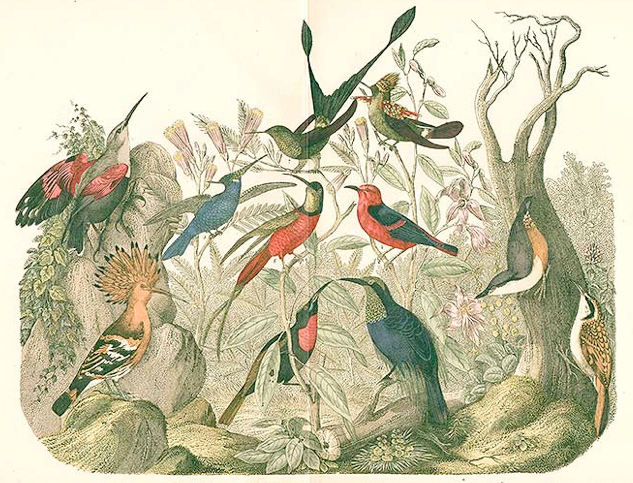Wild Bird Motifs

Birds were the harbingers of spring, and are quite frequently depicted on pysanky. Some ancient beliefs associated the ancient sun god with birds, and his handprint was said to be similar to a bird’s claw.
Birds were thought to be able to fly to heaven, and are sometimes pictured carrying letters in their beaks as they fly upwards. This, however, seems to be a fairly recent addition to pysanka symbols, and is found only on Hutsul pysanky.

Swallows are always shown in flight. They are a common motif on Lemko drop-pull pysanky, and you rarely see one–there is usually a line of them going around the egg. Both of the pysanky below are from Onyshchuk.


This is an example of a pysanky with the motif of a swallow’s tail from Kherson. This design was originally collected by Kulzhynsky in 1899. My suspicion is that is actually a berehynia motif of the “curl” type that was renamed.

Another bird sometimes depicted on Lemko pysanky is the stork. I have seen two such examples, so this may be a recently created symbol. The two pysanky below both apparently depict storks; the one on the left if from Binyashevsky, and the one on the right from Onyshchuk.


However, with the exceptions noted above, wild birds were usually pictured perched or standing, not flying, on pysanky. These pysanky are from Pokuttia and Poltavshchyna.


While most animals are depicted on pysanky only by their most characteristic features, wild birds were usually shown whole, and in profile.

Bird symbols on traditional folk pysanky were usually quite stylized; while they may be given the names of specific birds, they are not naturalistic in the least. For example, this “zozulia” from Lvivshchyna does not appear to have any features which wold suggest why it was called a cuckoo.

Most often the birds are quite simple; occasionally they might be given fanciful features.
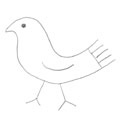
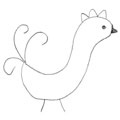
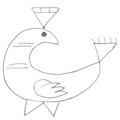
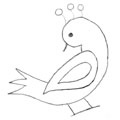
On diasporan pysanky one can often find quite intricate bird motifs, and even some that have the features of real birds. This is a diasporan feature, not a traditional one.

Occasionally, as in the pysanky below, you will see just part of a bird. On the left (Lemko, Onyshchuk) is a zozulia (cuckoo). On the right is a Boyko pysanka (Binyashevsky) called “Sorochati lapky” (magpie feet).


This interesting pysanka is from Podillia, and is called “Doves’ wings” (Yavoriv village, Pishchany raion, Vinnytsia oblast).

The motif is quite similar to hose usually referred to as “bear paws,” which themselves are a variation of the “hand of god” motif that dates back to the Paleolithic era.

More often you will see the whole bird, as with soroky (magpies) on the pysanka below on the left (Poltava region, Binyashevsky). The pysanka to its right is also called “Soroky,” but is probably just a renamed windmill motif. The arms of the windmill/svarha do appear to resemble bird heads a bit (Kyiv region, Binyashevsky).


This is an example of bird motif pysanky from Vinnytsia:

On the pysanky below you can see both traditional and a few more avtorski pysanky with depiction sof birds.
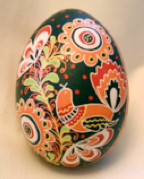

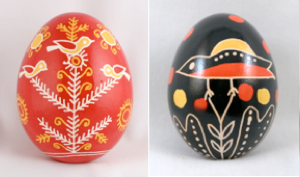
And, lastly, you can appreciate the variety of bird motifs on Ukrainian pysanky from this page of Vira Manko’s book «Летіть соловейки на рідгі земельки» (Fly, nightingales, to your native lands):
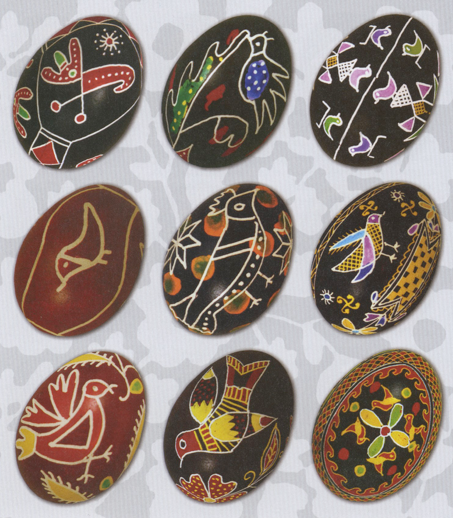
Heavenly Messengers, Harbingers of Spring
